
For years, skyrocketing home values and tight inventory gave sellers the upper hand. But the tide is turning. Across the U.S., homeowners are finding it harder to drive a hard bargain as economic uncertainty, elevated mortgage rates, and affordability constraints force buyers to push back.
In regions like the South and West, sellers are increasingly offering concessions—lower prices, mortgage rate buydowns, and help with closing costs or post-inspection repairs—to attract hesitant buyers. The shift is fueled by a surge in new construction and buyer fatigue over inflated asking prices.
While the national median listing price inched up to $439,450 in July, many metro areas saw declines. Bidding wars have cooled, replaced by low-ball offers and prolonged negotiations. Yet, despite this shift, the market remains sluggish: sales of previously owned homes are down 1.3% compared to last year’s already historic low.
Affordability remains a major hurdle. Realtor.com reports that the average buyer earning the median U.S. income can afford a $298,000 home—well below current listing prices. With mortgage rates hovering around 6.74%, seven out of ten buyers are priced out.
Homes Linger as Buyers Wait
Since mortgage rates began climbing in 2022, the housing market has stalled. Listings are up nearly 25% year-over-year, but many homes sit unsold. In states like Texas and Florida, inventory has surged due to new construction, giving buyers more choices and leverage. Meanwhile, the Midwest and Northeast still face tight supply, with inventory 40–50% below pre-pandemic levels.
Sellers Feel the Pressure
Doug McCormick, a retired business owner in Colorado, listed his mountain home for $1.3 million. After two months and multiple price cuts, he’s still waiting for an offer. “You only need one buyer,” he says, though he’s now considering renting the property.
In cities like Austin, Miami, and Chicago, listing prices have dropped by 4–5% year-over-year. Even with reductions, homes aren’t moving as quickly. Redfin agent Annie Foushee notes, “Sometimes it’s not enough to move the home.”
Navigating Both Sides of the Market
Lindsay and John Olesberg experienced the dual challenge of selling and buying. After listing their New Mexico home for $835,000, they sold it for $40,000 less. But in Austin, where inventory has jumped 60% since pre-pandemic levels, they bought a larger home for $30,000 below asking—and scored $1,000 in seller-paid fees.
Some Sellers Step Back
In buyer-friendly markets, homeowners like Tammy Tullis in South Miami are pulling listings rather than accept steep discounts. After dropping her $2.8 million asking price by $100,000 and receiving only low-ball offers, she removed the listing. “I want to sell, but I’m not in a rush-rush,” she says.
Will Lower Rates Help?
The Trump administration has urged the Federal Reserve to cut interest rates, hoping to stimulate the housing market. But mortgage rates are tied to the 10-year Treasury yield, not directly to Fed policy. Even if rates dip, increased buyer demand could reduce sellers’ incentive to negotiate.
Economists expect mortgage rates to hover in the mid-6% range through the end of the year, keeping affordability tight and negotiations tough.

